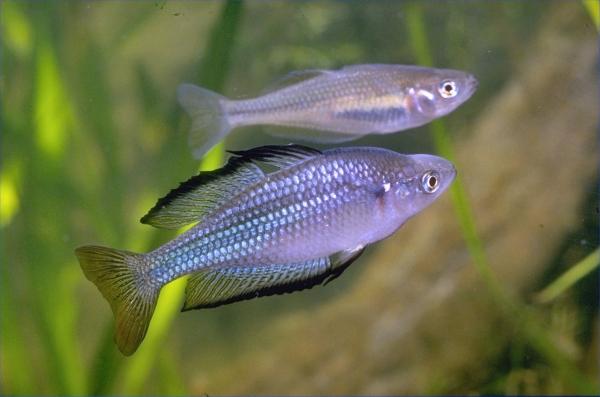AUSTRALIAN RAINBOWFISH
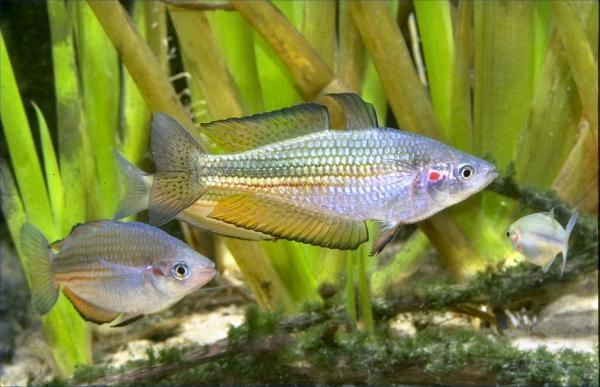
Above: M. duboulayi, Kin Kin River.
This is not an exhaustive list but a showing of those
species that I have kept and found suitable to my aquarium conditions.
The material on these pages referring to Rainbowfish and their
relatives was compiled from various sources, as part of my own learning
experience, getting to know my fish from what other sources had to say
about them. Pictures and text are used for educational purposes and used with
thanks. Additional comments are based on my own experience. I have placed
these notes online as an adjunct to the educational material that I wrote
on Ancient Gondwana Land cichlids and
rainbowfish.
Quick Index
Click here
for New Guinea species of Rainbows
|
Western Rainbowfish - Melanotaenia australis (Castelnau, 1875) syn.
Neoatherina australis
(Castelnau1875) |
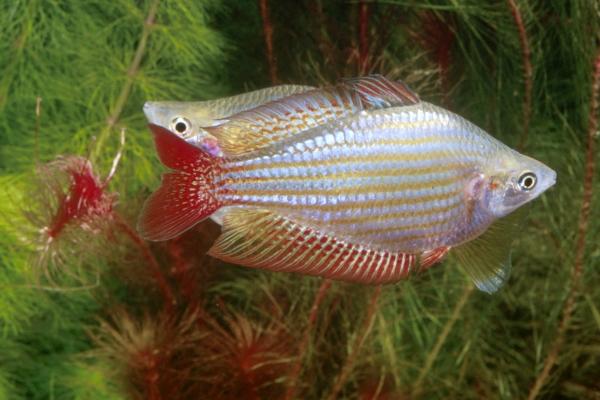 Melanotaenia australis [Blackmore
River] - photo© Günther Schmida |
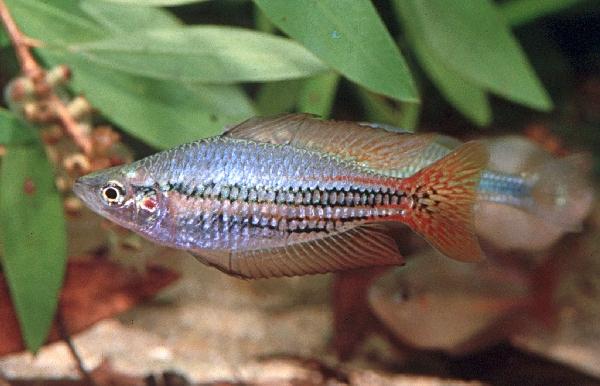 Melanotaenia australis [Drysdale River] - photo© Günther Schmida |
|
Description: a
colourful rainbowfish with a red tail. Castelnau first described this
species as Neoatherina australis in 1875. In earlier days they
were commonly known as the 'Westralian Sunfish'. In 1964 another
species of rainbowfish collected from the Northern Territory was named Melanotaenia
solata. After Gerald Allen's review of the rainbowfish family these
two species were considered as one and he placed them both in the large
"Splendida group" as a sub-species, and named them Melanotaenia
splendida australis, but recent DNA studies indicate that M. splendida,
M. australis and M. solata are
distinct species.
Distribution: widespread
in
north western
Australia; throughout the Pilbara region of Western Australia between
the
Ashburton and DeGrey Rivers and in the Kimberley region in the extreme
northern part of Western Australia between the Fitzroy River and the
Northern Territory border. Its natural range does not coincide with
that of M. solata.
Natural Habitat: freshwater
rivers and swamps; benthopelagic; pH range: 6.5 - 8.0 Climate:
tropical; 22 -
28°C;
hardness not tested, but varies with location and season (as does pH). |
Conservation Status: Not in
IUCN Red List.
Threats: Habitat
degradation, mining
pollution, feral animal (trampling swamps).
Size: Max. size: 10.0 cm TL;
8.0 cm TL
(female)
Water Requirements:
freshwater tropical,
pH 6.5- 8.0; ? dGH 10.
Tank Habitat: large tank with free
swimming
space, well planted and with some plant cover at the surface.
Diet: Omnivorous. Small crustaceans and
insect larvae, vegetable matter- algae and Duck Weed; will eat flake
foods,
blood worms and daphnia; adaptable to flakes and granules.
Sexing: Males have
a deeper body shape and larger dorsal fins.
Reproduction:
Scatterer, non-guarder; spawns in plant growth.
Tank Community: Keep in
shoals of 6
or
more.
Incompatible Species: Unknown
Comments: An easy to
keep
fish,
needing plenty of room and floating weed cover to overcome
timidity.
Keep in shoals of 6+.
|
|
Eastern Rainbowfish -
Melanotaenia duboulayi
(Castelnau,1878; Allen, Midgley, Allen
2002) syn. Atherinichthys duboulayi; Duboulay's
Rainbowfish; Melanotaenia splendida
splendida (Peters, 1866); Splendid
Rainbowfish. |
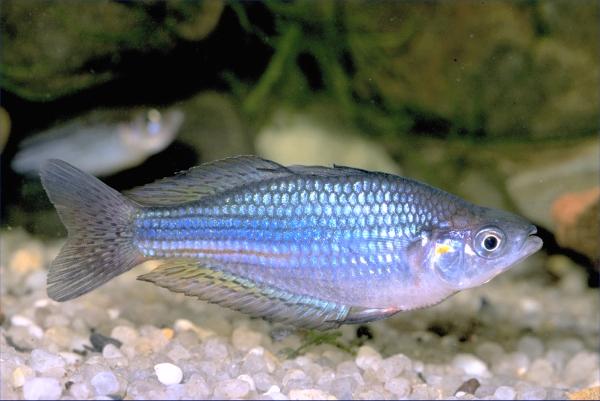
Eastern Rainbowfish from Burnett River,
photo© Neil Armstrong
|
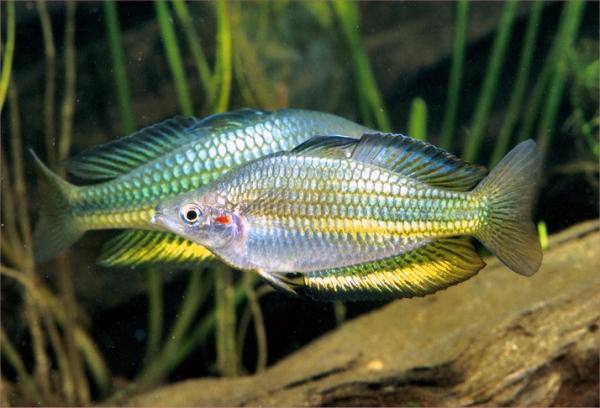
Eastern Rainbows from Gin Gin Creek.
photo© Günther Schmida |
|
Description: Large, deep
bodied
Rainbowfish, with small head, iridescent scales.
Distribution: NE Australia:
river systems east of the Great Dividing Range of Queensland,
Australia,
from the vicinity of Gladstone (Boyne River) north to the eastern
watershed
of Cape York Peninsula.
Natural Habitat:
benthopelagic; depth
range
1 - 0 m; inhabits rivers, creeks, streams ,lakes, drains, ponds,
dune lakes and reservoirs, often forming large schools
at the surface. Temperatures in their environments range from 20 to 29
°C and pH from 5.3 to 8.5 and the water varies from clear to
turbid. Usually occurs in still or slow-flowing
conditions
near the surface or around vegetation, log snags, or other debris.
Conservation Status: Unknown. Not in IUCN
Red List.
Economic use:
Commercial aquarium trade.
Threats:
habitat
destruction.
Size: Max. size: 9.0 cm SL;
6.5 cm
SL
(female).
Water Requirements:
Subtropical,
freshwater
conditions, pH 6.5 - 8; water temperature 20o - 22oC;
pH 7.0 - 7.5 ideal; dGH 10-12; temperature 20 - 25°C.
Tank Habitat: large, tropical
freshwater tank, with good aeration and a fitted cover plate in
place. Sandy substrate, well planted with surface plant cover if possible;
duck weed cover is ideal.
|
Diet: Omnivourous; mainly
small
insects
and crustaceans. Feed flakes, small pellets; most small live foods,
beef-heart.
Sexing: Difficult in young
fish;
adult females
have deeper body outline, males slimmer, colour more intense.
Reproduction: dioecism,
external,
non-guarders. Spawns in plant growth;
scatterer, non-guarders.
Tank Community: Peaceful with
other
fish, older males may chase similar sized fish; compatible with quiet
fishes. Keep in small shoals of at least 6 fish.
Incompatible Species: Small
fish
fry!!
Comments: Colour varies with
environment
and mood. An easy
fish to keep: ideal for beginners at keeping Rainbowfish; keep the tank
well covered to prevent them jumping out.
Due to some members of the fish trade still calling this fish Melanotaenia
splendida splendida, it is confused with
M. australis, M. fluviatilis and M. solata. I
suspect that hybrids also exist under the name Melanotaenia
splendida. This species tolerates low levels of
nitrite and can be used in new tanks, with care. |
|
Lake
Eacham Rainbowfish - Melanotaenia eachamensis
(Allen & Cross, 1982)
Description: Laterally compressed,
small-headed, golden bronze Rainbowfish. Considered a "sister species" to M. utcheensis.
Distribution: occurs in Lake Eacham, a circular,
crater lake situated on the Atherton Tableland in northern Queensland,
Australia, where it is extinct; also
discovered in nearby Lake Euramoo and some local streams.
Natural Habitat: benthopelagic; freshwater
Climate: subtropical; 24 - 30°C. Lives in clear, shallow water along
the shoreline of Lake Eacham. Often found among aquatic vegetation, fallen
logs or branches.
Conservation Status: Not in IUCN Red
List: it must be consider to be vulnerable due to its limited distribution
and threats. The species was declared extinct in Lake Eacham in 1980;
it exists in captive populations and in new locations found near Lake Eacham.
Size: Max. size to 6.5 cm SL
Water Requirements: freshwater; temperature ranging from 23-27° C
and pH 7.0 respectively.
Threats: Habitat destruction; introduction of the
native predator fishes
Mouth Almighty (Glossamia aprion), Barred Grunter (Amniataba percoides)
and Archerfish (Toxotes chatareus).
Tank Habitat: well planted tank, with neutral pH.
Diet: Small aquatic insects and
crustacea.
|
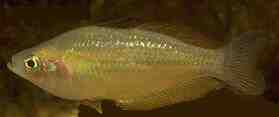
Melanotaenia
eachamensis inhabits a crater lake.
Sexing:
Females
less deep in body shape.
Reproduction: dioecism, external, egg layer:
not much is known of the biology of this fish.
Tank Community:
As for other rainbows; with plant cover.
Incompatible Species:
Does best in a species only tank as a conservation project.
Comments: The golden colour of the Lake Eacham
Rainbow is very attractive. In the interests of saving Australia's biodiversity,
this species needs protection.
|
River Murray Rainbowfish -
Melanotaenia fluviatilis
(Castelnau,1878,et al.) syn.
Aristeus fluviatilis, Nematocentris fluviatilis, Melanotaenia
splendida fluviatilis;
Australian
Rainbowfish, Crimson-spotted Rainbowfish, Pink-ear, River Murray
Rainbowfish,
Murray-Darling Sunfish.
|
Melanotaenia fluviatilis (male) photo© Günther Schmida
|
Melanotaenia fluviatilis
Goldburn River photo©
Günther Schmida
|
|
Description: a small,
slightly
laterally
compressed fish with small head and iridescent, green-blue body colour (reflects
available light); silver
below, olive above; faint lines of red spots between the rows of scales; very faint lateral line stripe and reddish
tail. Dorsal and anal fins edged in black.
Distribution:
endemic to Australia, in the Murray-Darling system.
Natural Habitat: benthopelagic;
freshwater
tropical, riverine; 10-30°C (seasonal variations tolerated, av. is 22 - 25°C
in summer and down to 10°C in winter; pH range: 7.0+; dGH range: av.
10.0.
Found in rivers, billabongs and creeks, drains, ponds, dams
(introduced)
and reservoirs. Occurs usually in still or slow-flowing conditions.
Conservation Status: Not in IUCN
Red List.
Threats: Pollution, river
salinisation and habitat destruction; extinct in
much of its former range due to agricultural pollution, draining, and
development. Survives in unpolluted rivers, billabongs,
creeks,
drains, ponds, dams (introduced) and reservoirs. NEEDS PROTECTION.
Economic use: Commercial aquarium trade and aquaculture for stocking
dams.
Size: Max. size: 9.0 cm SL; 7.0 cm
SL
(female)
Water Requirements: freshwater pH
7.0-
7.4, dGH10.0., 24°C.
Tank Habitat: still freshwater,
well
planted,
sandy substrate, plenty of swimming room. Cover the tank, as this
fish jumps when startled.
|
Pond
Habitat: large pond, at least 60 cms deep, with good
aeration and planting; duck weed cover is ideal. Can be kept in
dams and as an ornamental pond fish in warmer climates (water temp. never less
than 10°C.
Diet: Omnivorous. Feed
beef-heart
mix, blood worms, black worms, mosquito larvae, flakes, small pellets,
Tetra Bits.
Sexing: Females have deeper
body
outline, males larger, slimmer, with fins more colourful than females.
Reproduction: dioecism, external,
spawns
in plant growth; non-guarders.
Tank Community: An active,
schooling
species best kept in groups of 6 or more;
suits community tank with Blue-eyes, Red-tailed gudgeons and other
large
Rainbows.
Incompatible Species: Carp (ruin habitats);
large cichlids.
Comments: An
active,
shy fish, that requires a covered tank (leaps well if startled), and
best
kept in schools of 8+. Can be kept without additional heating in homes in Sth
Australia and in areas of the the Murray-Darling basin. Natural light makes the colours appear far
better
than artificial light. This is the ideal Australian
native fish for use in mosquito control in Australian dams: help get
rid of the feral fishes.
Adapts well to culture in dams and is the
preferred species to keep instead of feral pests such as European Carp
and "Dambusia" (Gambusia sp.),
the
so-called Mosquito Fish. |
|
Macculloch's Rainbowfish
- Melanotaenia maccullochi (Ogilby,
1915) Macculloch's
Dwarf Rainbow, Cairns Red-finned Rainbowfish.
Description:
A small rainbowfish, with
laterally compressed body. Several geographically isolated populations are
found in New Guinea, Northern Territory, northern Queensland. So far,
genetic data separate
Melanotaenia maccullochi into three groups, Burtons Creek, Etty Bay
and Cape York populations. Male specimens of the variety found between
Cairns and Innisfail have deep, black, irregular, horizontal stripes along
a silver body. The dorsal and anal fins are orange-red with a lower
black margin running along the body line. The caudal fin has a fan of
orange-red colouration. Females are much less colourful, though some do
show a hint of the male's coloration. The Harvey Creek and Cairns Red-
Finned varieties are similar.
The variety found in the drainage division of the Jardine River are
characterised by a series of fine black stripes on the sides, with black
submarginal bands and white to yellowish margins on the dorsal and anal
fins. Females generally have the stripes less defined. They are also
much smaller than the other varieties, both in length and body depth.
Species Diagnosis:
Dorsal
spines
(total): 5-8; Dorsal soft-rays (total): 7-12; Anal spines: 1-1; Anal
soft-rays:
13-19.
Distribution: Australasia; Papua New
Guinea (lower and middle sections of the Fly River westward to
the Bensbach River) and northeastern Australia (3 separate populations as
noted above).
Natural Habitat: benthopelagic; freshwater; pH
range: 7.0; dGH range: 10.0; Climate: tropical; 20 - 25°C. Inhabits
lowland swamps and small streams, usually in clear, acidic waters with
ample cover in the form of log debris or aquatic vegetation.
Conservation Status: Not in IUCN Red
List.
Threats: Habitat degradation.
Size: Max. size: 6.0 cm SL
Water Requirements: tropical freshwater 20 -
25°C.; pH range: 7.0; dGH range: 10.0;
Tank Habitat: dense planting and logs.
Diet: Omnivorous. Adapts to flakes.
Sexing: Males have a deeper body profile and
longer fins. Females tend to grow larger and have more rounded bodies than
males.
Reproduction: dioecism, external,
non-guarders.
|

M. maccullochi, Harvey Creek.
Tank Community: The Australian form from
Harvey Creek seems adaptable to water conditions from soft to moderately hard, pH adjusted to 70. - 7.4. Makes a good community fish
with other rainbows and gudgeons requiring similar water conditions. If kept
with M. praecox the males may display aggression but do no damage
in such displays..
Incompatible Species: Large fishes,
rainbowfish that prefer alkaline water, Arowanas (Yes, mine swallowed them in
one gulp when he grew big enough and decided that his tank mates were food).
Comments: I have found that in a
community tank they shoal with Tetras and dwarf rainbows of a similar size.
The
fish from the Jardine River and the Etty Bay populations blue and black.
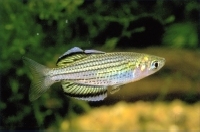 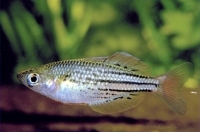
M. maccullochi,
Jardine River
M. maccullochi,
Etty Bay |
|
Black
Banded
Rainbowfish -
Melanotaenia nigrans (Richardson, 1843)
Description:
Colourful rainbowfish;
deep
bodied, with prominent black lateral line stripe.
They can be
recognised by a more slender body than most other rainbowfishes. This is the type species for Genus
Melanotaenia.
Distribution: Melanotaenia
nigrans has a discontinuous distribution across northern Australia,
from the Kimberley region in Western Australia, across the northern
part of the Northern Territory to Cape York Peninsula in northern
Queensland, including a number of offshore islands such as Groote
Eylandt in the Gulf of Carpentaria and Prince of Wales Island in Torres
Strait.
Natural Habitat:
benthopelagic;
freshwater;
brackish; pH range: 5.2 - 5.6; dGH range: 10.0 Melanotaenia nigrans has been found in a variety of freshwater
environments
but seem to prefer slow-flowing clear water streams, billabongs, and
swamps
with abundant aquatic vegetation.
Climate: subtropical; 18 - 24°C. Inhabits rainforest streams, lily
lagoons and small streams. Also occurs in larger streams, usually in
backwaters
or along the shoreline where there is minimal flow and grassy
vegetation.
Often found in brackish, coastal waters.
Conservation.Status: Not in
IUCN
Red List.
Importance: aquarium: commercial.
Threats: Threatened:
commercial
over
harvesting
for aquarium trade; habitat degradation.
Size:
Max. size: 10.0 cm TL; may reach a maximum size of 12 cm, but usually
less than 7 cm.
Water Requirements: freshwater OR
brackish
water; pH range: 5.2 - 6.7; dGH range: 10.0; temperature 20°C- -
24°C.
Known in water to 35°C.
Tank Habitat: Well planted,
depending
on water conditions (brackish or freshwater) to provide adequate hiding
places among submerged roots and branches; plant with Java Fern in
brackish
conditions. |
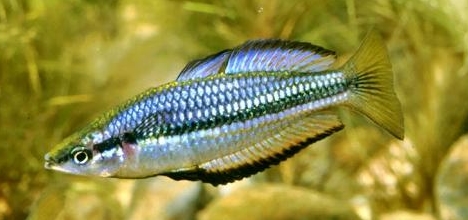
Diet: Feeds mainly on aquatic and
terrestrial
insects and their larvae, and also filamentous green algae.
Sexing:
Melanotaenia nigrans is sexually dimorphic. In males, the spines of the
first dorsal are usually extended and may lie well past the origin of the second
dorsal when not erect. The posterior rays of the second dorsal and anal fins are
extended caudally and may extend past the origin of the caudal fin. In females,
the first dorsal spines are short, not reaching the origin of the second dorsal.
The posterior rays of the anal and second dorsal fin are not extended. The
spines and outer rays of the ventral fins of some males are also extended and
may reach past the vent and the origin of the anal fin. Males larger than
females. They can be
recognised by a more slender body than most other rainbowfishes and
may reach a maximum size of 12 cm, but usually less than 7 cm.
Reproduction: dioecism, external,
non-guarders.
Tank Community: species tank is
best;
community fresh water tanks OK; Keep in shoals of 6 or more.
Incompatible Species: larger fish. |
|
Northern Rainbowfish -
Melanotaenia solata (Taylor, 1964) Darwin Rainbowfish, Adelaide
River Rainbowfish.
Description: a
colourful
rainbowfish
with a red tail; similar to M. splendida rubrostriata but paler
in colour, with black and red stripes; some geographic variation exists, with deeper colours in some forms. In
specimens from Yirrkala, the dorsal and anal fins are red; the caudal
fin yellowish is orange; the pelvic fins are deep red; lower side
bluish silvery; scale centres on side generally golden bronze; they
form about five longitudinal rows, the lowermost of which is
approximately on a level with the ventral surface of the caudal
peduncle.
Distribution: Occurs in the north-western Northern
Territory from the Fitzroy River to the Adelaide River, just
east of Darwin. Confined primarily to Arnhem Land, Northern Territory
between the South Alligator and Walker Rivers. Also found on the larger
offshore islands of the Gulf of Carpentaria including Groote Eyland and
Bickerton Island. This species was common in lowland tributaries and flood
plains around
submerged vegetation and swamps, of the Adelaide River, Northern
Territory,
and in associated swamps and tannin rich pools. When viewed from
above their deep, red tails flashed like beacons. Also common in the Alligator
River, southern Arnhem Land.
Natural Habitat:
benthopelagic; freshwater
rivers and swamps; pH range: 6.5 - 8.0 Climate: tropical; 22 -
28°C;
hardness not tested, but varies with location and season (as does pH).
Conservation Status: Not in IUCN Red
List.
Threats: Habitat
degradation, mining
pollution, feral animals (trampling of swamps).
Size: Max. size: 10.0 cm TL; 8.0 cm
TL
(female).
Habitat & Ecology: A stream
dwelling rainbowfish mainly found around sub-surface vegetation,
submerged logs, or branches in small tributary streams, but can also
occur in swamps and lagoons. Their natural environment is subjected to
seasonal variations with water temperature, pH, and hardness levels
varying considerably. There is often a large fluctuation in water
conditions between the dry and wet seasons. Males are easily
distinguished from females by their brighter colours and longer and
more elongated dorsal fin rays. Growing to a length of around 10 to 12
cm, males are usually much larger and deeper bodied than females.
Spawning occurs from October to December, with females producing
between 100 and 200 eggs. Eggs adhere to water plants and hatching
occurs around 6 to 10 days. Growth is rapid reaching 2-3 cm in 10 to 12
weeks.
Tank Habitat: large tank with
free
swimming
space, well planted. Water parameters pH 7.0 8.0; dGH 10, temperature 25-27oC.
I found that pH and water hardness was
not a concern with M. solata, however the water needed to be
well aerated and nitrite free. Cover the tank with a cover plate. An easy to keep
fish, needing plenty of room and floating weed cover to overcome
timidity. Keep in shoals of 6+.
Diet: Omnivorous. Small crustaceans and
insect larvae, vegetable matter- algae and Duck Weed; will eat flake
foods,
blood worms and daphnia; adaptable to flakes and granules.
Sexing: Males have
a deeper body shape and larger dorsal fins.
Reproduction: Spawns in plant
growth.
Water Requirements: freshwater tropical, pH
6.5- 8.0; ? dGH 10.
Tank Community: An active fish; keep in shoals of 6 or
more; OK with other rainbows; suitable for community tanks.
Incompatible Species: Larger fish.
|
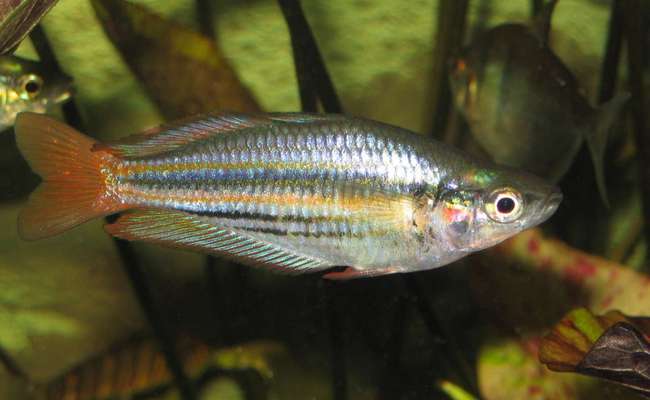
Melanotaenia solata
Comments: This was the first Rainbowfish
that I kept, with the specimens coming from swamps near the Adelaide River, N.T.
I found that they varied in colour from billabong to billabong, some having a
deeper brown to black longitudinal, lateral line stripe running from the eye to
the tail and more or less prominent, golden stripes on either side of the
lateral line stripe. Others showed variation in the red colouring on the tail,
dorsal and anal fins. The waters were usually tannin-rich and deep, with the
fish swimming near the surface and among sunken vegetation. They were very
active fish, hard to catch in daylight but adapted to aquarium life easily.
I found that small, wild-caught specimens adapted well to an
aquarium and showed good colour development as they aged. The
tanks were well planted and had leaf cover at the surface, as the fish were
easily frightened.
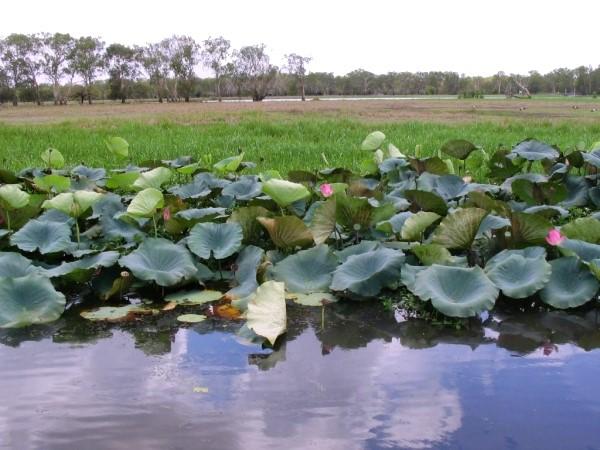
Billabong in Kakadu- a typical habitat for
M. Solata.
|
|
Melanotaenia splendida
(Castelnau 1875) The taxon,
Melanotaenia splendida (Castelnau 1875, 1878) included species that are
no longer placed in that taxon (e.g.
M. australis, M. duboulayi, M. fluviatilis, M. solata, M. tatei).
However, while the
name 'splendida' is still widely used to refer to several species that
may appear similar, recent DNA studies and some aspects of
reproduction habits differ sufficiently for different species
status to be given. Hence M. australis, M. duboulayi, M. fluviatilis, M. solata, M. tatei are removed from the former "splendida
complex".
I currently keep M. splendida
and the captive bred fish resemble those known as Melanotaenia splendida
inornata. I also keep M. fluviatilis and the two
species are distinctly different in appearance.
M. splendida is a variable species, and
specimens from different creeks and streams are now being sold in Australia under the name of their place of origin. |
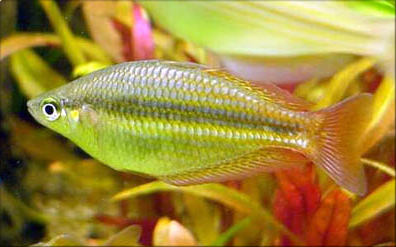
Melanotaenia splendida |
|
Dawson River Rainbowfish -
a form of Melanotaenia splendida
splendida OR M. fluviatilis?
Description: a small,
slightly
laterally
compressed fish with small head and iridescent, green-blue body colour; silver
below, bluish above; faint lines of orange-red spots between the rows of scales; very faint lateral line stripe
anteriorly and bluish
tail. Dorsal and anal fins edged in blue-black. This fish has been grouped in as
a Melanotaenia splendida splendida, but some scientists believe it
may be related to a M. fluviatilis.
Distribution:
endemic to Australia, in the upper, Fitzroy-Dawson River system, Queensland, which
drains a large portion of Central Queensland and empties into the sea at
Rockhampton, on the Tropic of Capricorn.
Natural Habitat: benthopelagic; freshwater
tropical, inland riverine; 10-30°C. Although found in the tropics, its
occurrence in the inland
reaches, where it is very cold during winter and at night, means that this
species is adapted to long periods of cool temperatures. They regularly
endure temperatures around 11C and are able to tolerate very high
temperatures as well. They are reputedly are very robust fish.
|
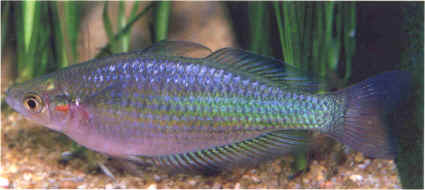
The Dawson River Rainbowfish
They are available by this
name and make beautiful aquarium fish for unheated conditions
in Australian homes. They should be kept so as not to hybridise
with other Rainbows, to keep the form pure. |
Melanotaenia splendida
inornata (Castelnau 1875) Chequered
RainbowFish.
Description: Large rainbowfish, with small head; blue
iridescence to body and scales which appear in a chequered
pattern, with red lines between each row of scales; lateral line
is dark blue-black; males have dorsal fins chequered yellow and
black, with bluish-black edges; females are coloured paler
versions of the male with less chequered patterns on fin. Some geographic
variation exists, with colours deeper or with redder fins, similar to
M. splendida rubrostriata but paler in colour; every river seems to
sport its own colour form.
Distribution: They inhabit the river
systems of the Northern Territory and Queensland, which flow
into the Arafura Sea and Gulf of Carpentaria, and the Prince of Wales and Badu
Islands in the Torres Strait. Northern Australian occurrence ranges from
Darwin to Cape York Peninsula, in coastal streams east of the
Mary River and flowing into the Gulf of Carpentaria, to the
Jardine R. and western Cape York Peninsula and extending down
the east coast to around the Lockhart and Stewart Rivers. Natural Habitat: benthopelagic; riverine; freshwater
rivers and swamps; pH range: 6.5 - 8.0 Climate: tropical; 22 - 28°C;
hardness dGH range 9.0 - 19.0., varies with location and season (as does
pH).
Conservation Status: Unknown.
I suspect that the trade offers hybrids of this species under a variety of
trade names, including M. splendida.
Threats: Unknown.
Size: Approx. 6.0 cms.
Water Requirements: Freshwater; Soft
and slightly acidic (6.8 - 7.0); adaptable to near neutral water.
Temperature 25- 27oC. Good filtration required.
Tank Habitat: Planted tank with open swimming spaces.
Diet: Small crustaceans and insect
larvae; brine shrimp, mosquito larvae, red midge larvae, blood worms and
daphnia serve as live foods for captive fish; will eat flake foods, adaptable to flakes
and granules. Eats Duck Weed (Lemna minor).
|
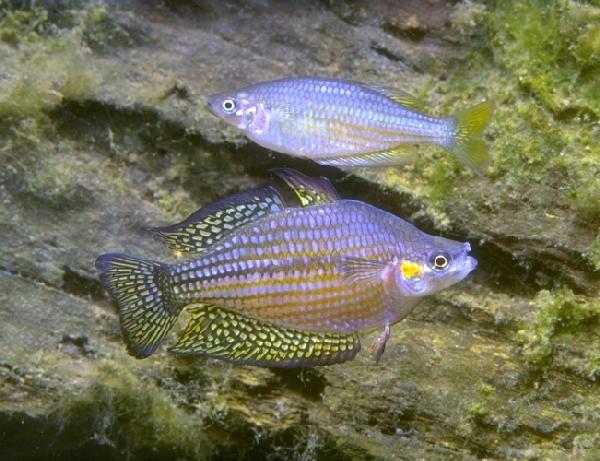
M. splendida inornata
Sexing: Males brighter and deeper
bodied; first dorsal fin longer in males and reaches the second dorsal
fin- females do not. All fins more colourful in the male, with more
pronounced yellow and black chequered pattern.
Reproduction: Spawn in plant growth.
Tank Community: Peaceful, active in
shoals. Keep in shoals of 6 or more.
Comments:
Adult males can be aggressive towards other Rainbows. Keep these fish in
shoals of 6+ with plant cover.
Considered a difficult fish to keep in water with an elevated temperature,
as this species is subject to Epizootic Ulcerative Syndrome or 'red spot'
disease. |
|
Melanotaenia tatei
(Zietz, 1896, et al) Desert Rainbowfish Syn. Melanotaenia splendida
tatei
Description: Large rainbowfish, similar to M. australis
but more silvery in colour; some geographic variation exists.
Distribution: inland Northern Territory, Queensland and N. E.
South Australia, in permanent waterholes, springs and rivers.
Natural Habitat: benthopelagic; freshwater;
pH range: 6.0 - 8.0; dGH range: 10 - 30.0, varies with seasonal rains;
climate: tropical; 20o - 30°C. Night temperatures can drop
quite low, to near freezing.
Conservation Status: Not in IUCN Red
List.
Threats: Unknown; may be at risk due to
desertification and climate change.
Size: Max. size: 10.0 cm TL
Water Requirements: freshwater, 20o
- 25oC; pH range 6.0 - 8.0; dGH < 30.0; adaptable to a wide
range of conditions due to its habitat being seasonally flooded. Water is
usually hard and high pH, varying after heavy rains and floods.
Tank Habitat: a well lit, large tank,
tropical, 20o
- 25oC, hard water, pH above 7.2; well provided with
hiding places among logs, plants and pebbles. This species can be kept indoors
without heating in the tank in most places in Australia, making it adaptable as
an aquarium species for unheated tanks. Cover the tank well, as this fish jumps.
|
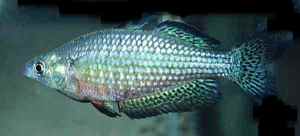
Tate's Desert Rainbowfish
Diet: Omnivorous, opportunistic. Small
crustaceans and insect larvae; will eat flake foods, blood worms and
daphnia; adaptable to flakes and granules.
Sexing: Males brighter in colour; slender;
females deeper bodied.
Reproduction: egg layer, probably
scatterers; little biology and ecology is available for this fish.
Tank Community: species tank; keep in shoals
of 6 or more.
Incompatible Species:
Comments: An adaptable, shoaling species
that is becoming more readily available in Australia from captive fish farmed
from stock from the Barcoo. I have found that a surface cover of floating plants
(Duck Weed) helped with timid fish. |
|
Melanotaenia
trifasciata (Rendahl, 1922) Banded Rainbowfish
Description: Deep bodied fish with marked
longitudinal stripes, wide black lateral line stripe, red fins edged in
black and iridescent scales.
Distribution: Northern Territory and Queensland,
Australia.
Natural Habitat: benthopelagic; freshwater; pH
range: 7.0 - 8.0; dGH range: 9.0 - 19.0; occurs at temperatures ranging
from 22°-30° C. Lives mainly in small streams and waterholes in clear to
moderately turbid water. Occurs over rocky or gravel bottoms or in
well-vegetated areas, frequently around submerged logs and branches.
Climate: tropical; 25 - 30°C.
Conservation Status: Unknown.
Threats: Unknown.
Size: Max. size: 11.0 cm SL.
Water Requirements: hard freshwater,
tropical, temperature range 25 - 30°C, pH 7.0 - 8.0; dGH range 9.0 - 19.0.
Tank Habitat: gravel substrate and rocks or
well planted and landscaped with rocks and branches. Cover.
Diet: Omnivorous; takes small crustaceans,
black worms and flake foods.
|
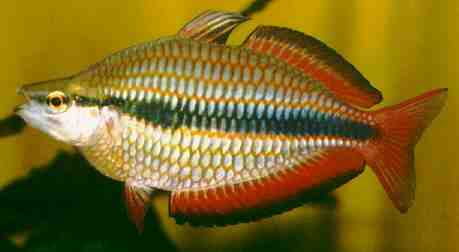
Melanotaenia trifasciata
Sexing: Males larger than females,
with deeper colours.
Reproduction: Spawns in plant growth.
Tank Community: Keep in shoals of 6 or more.
Incompatible Species: Unknown.
Comments: Needs space and cover.
Reportedly found associated with Melanotaenia splendida inornata and
Melanotaenia nigrans.
|
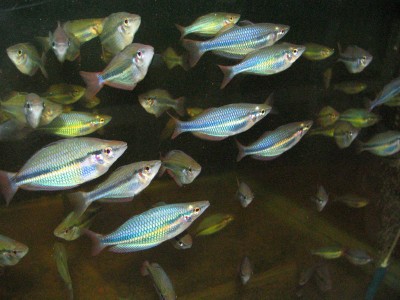
A tank of
Wonga River M. trifasciata and the Cato River form at
right, shows the variation in this species. |
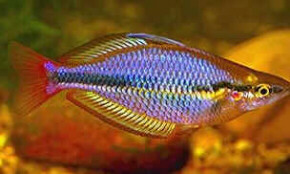
The rare, Cato River form, of M. trifasciata
Melanotaenia trifasciata Cato River is one of
the new rainbows being
developed in Australia. It is a very colourful form of
the species and will probably be much sort after. It comes from
the Cato River near Dhalinbuy, in the Northern Territory and is
a tropical species.
The future looks bright for Rainbow enthusiasts in Australia. |
|
Utchee Creek Rainbowfish
- Melanotaenia utcheensis
(McGuigan 2001)
Description: small, Australian, laterally
compressed rainbowfish; deep body body golden olive above, paler below,
with silvery blue iridescent scales; has distinctive, bluish, mid-lateral stripe
edged in orange/red stripes; four red stripes, 2 above and 2 below the
lateral stripe, are prominent in adults. Compared to M. splendida, this species has a somewhat larger eye (indicating its
darker, rainforest origins). The species was previously regarded as
being a colour variety of either the Regal Rainbowfish, M.
trifasciata or the Eastern Rainbowfish, M. splendida splendida.
However, following mtDNA sequencing (McGuigan et al, 2000) and
morphometric analysis (McGuigan 2001), it was elevated to species status.
Distribution: limited to the
coastal tributaries of the North and South Johnstone Rivers, and to
tributaries of the North Johnstone on the Atherton Tableland,
Queensland, Australia. Collected from Utchee, Fisher, Rankin and
Short Creeks in the North and South Johnstone River catchments in north
Queensland.
Natural Habitat: benthopelagic; freshwater; found
in sites with moderate to high water flow over cobbles and boulders.
Climate: subtropical; 24 - 30°C. The surrounding, natural
vegetation was tropical rainforest, but this has been cleared to the
stream banks. The waters of Utchee creek are on the coastal plain and
grazing and dairying on the Tablelands. The impacts of clearing and
agriculture on water quality are...
- increased sunlight onto water and rocks increases water
temperature locally and downstream,
upsetting the timing of seasonal events like spawning
- a decrease in the amount of leaves and fruits falling into the
water
- a decrease in the amount of terrestrial insects falling into the
water
- a decrease in the numbers of snags and overhangs on the stream
banks,
where small fish find shelter
- an increase in sediments from run-off events
- an increase in fertilisers from run-off events
- an increase in pesticides from run-off events
- an increase in spray drift from aerial spraying of bananas. [Source]
Given the habitat denudation, this species MUST be protected
and conserved. |
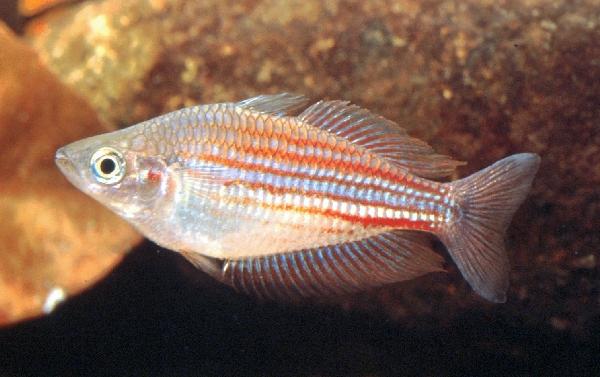
Melanotaenia utcheensis - photo© Günther Schmida
Conservation Status: Not in
IUCN Red List: it must be consider to be vulnerable due to its limited
distribution and severe threats. Local groups are
lobbying for endangered species status.
Size: Max. size to 6.5 cm SL
Water Requirements: freshwater;
temperature
ranging from 23-27° C and pH 7.0 respectively.
Threats: introduced fishes (Tilapia);
habitat and water degradation- the habitat environment has been developed for
intensive sugarcane and banana growing and grazing, removing the rainforest and affecting the creek.
Tank Habitat: well planted tank, with neutral pH; adapts to pH to
7.4 OK.
Diet: Small
aquatic insects and crustaceans. Adjusts to flake foods.
Sexing:
Females
less deep in body shape; body colour golden yellow
Reproduction: dioecism, external, egg layer:
not much is known of the biology of this fish.
Tank Community:
As for other Australian rainbows; with plant cover.
Incompatible Species:
Does best in a species only tank as a conservation project.
Comments: Peaceful. Needs conservation and protection. Shoals with
other rainbows in captivity and may hybridise. Breeders should not allow
hybrids to develop and displace fish that are true to breed.
|
Link to Notes of Keeping New Guinea
Rainbows
A Flashing Blaze in Rainbowfish
Link to Notes on
Keeping Australasian Blue-eyes- fishes also related to the the Rainbows.
Breeding and
Raising Rainbowfish Fry
INDEX PAGE
Return to
Previous Page TOP

THANKYOU FOR
VISITING ANOTHER WATERSHED AQUACULTURE EDUCATIONAL SITE
GOOD LUCK WITH YOUR RAINBOWS

Disclaimer
|
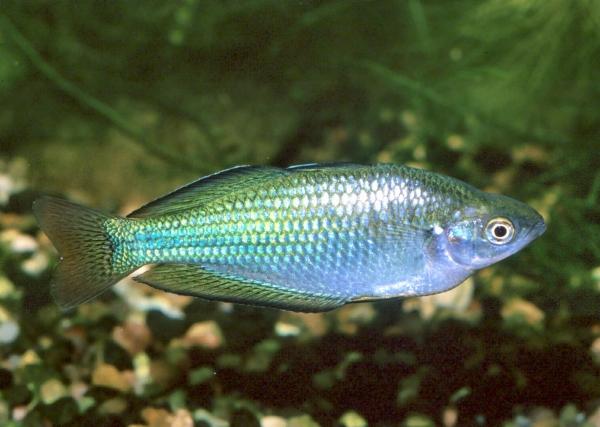



![]()





